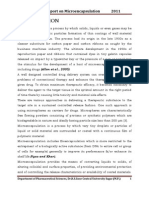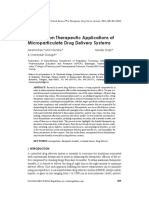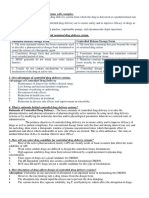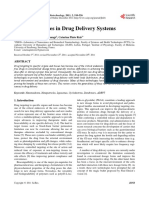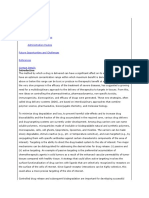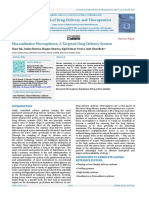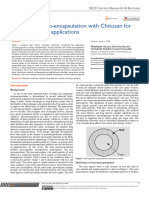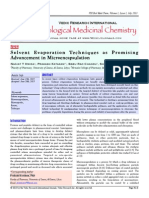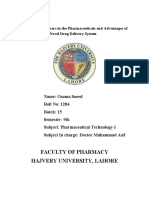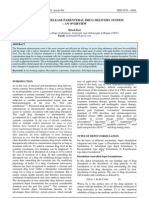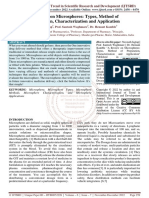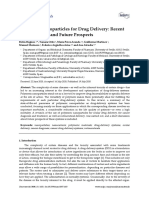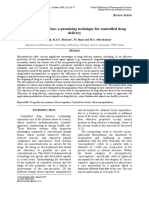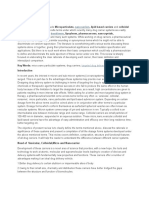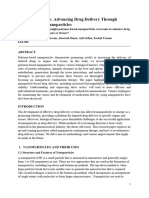Microsphere: A Review: IJRPC 2011, 1
Microsphere: A Review: IJRPC 2011, 1
Uploaded by
Mahendra ReddyCopyright:
Available Formats
Microsphere: A Review: IJRPC 2011, 1
Microsphere: A Review: IJRPC 2011, 1
Uploaded by
Mahendra ReddyOriginal Title
Copyright
Available Formats
Share this document
Did you find this document useful?
Is this content inappropriate?
Copyright:
Available Formats
Microsphere: A Review: IJRPC 2011, 1
Microsphere: A Review: IJRPC 2011, 1
Uploaded by
Mahendra ReddyCopyright:
Available Formats
IJRPC 2011, 1(4)
Sahil Kataria et al.
ISSN: 22312781
INTERNATIONAL JOURNAL OF RESEARCH IN PHARMACY AND CHEMISTRY Available online at www.ijrpc.com
Review Article
MICROSPHERE: A REVIEW
Kataria Sahil1, Middha Akanksha1, Sandhu Premjeet1, Ajay Bilandi and Bhawana Kapoor
1 Seth
G. L. Bihani S.D. College of Technical Education, Institute of Pharmaceutical Sciences and Drug Research, Sri Ganganagar, Rajasthan, India. *Corresponding Author: sahilkataria2010@gmail.com
ABSTRACT Microspheres are characteristically free flowing powders consisting of proteins or synthetic polymers having a particle size ranging from 1-1000 m. The range of Techniques for the preparation of microspheres offers a Variety of opportunities to control aspects of drug administration and enhance the therapeutic efficacy of a given drug. There are various approaches in delivering a therapeutic substance to the target site in a sustained controlled release fashion. One such approach is using microspheres as carriers for drugs also known as microparticles. It is the reliable means to deliver the drug to the target site with specificity, if modified, and to maintain the desired concentration at the site of interest. Microspheres received much attention not only for prolonged release, but also for targeting of anticancer drugs. In future by combining various other strategies, microspheres will find the central place in novel drug delivery, particularly in diseased cell sorting, diagnostics, gene & genetic materials, safe, targeted and effective in vivo delivery and supplements as miniature versions of diseased organ and tissues in the body. Keywords: Microspheres, controlled release, therapeutic efficacy, novel drug delivery.
INTRODUCTION Microspheres are small spherical particles, with diameters in the micrometer range (typically 1 m to 1000 m). Microspheres are sometimes referred to as microparticles. Microspheres can be manufactured from various natural and synthetic materials. Glass microspheres, polymer microspheres and ceramic microspheres are commercially available. Solid and hollow microspheres vary widely in density and, therefore, are used for different applications. Hollow microspheres are typically used as additives to lower the density of a material. Solid microspheres have numerous applications depending on what material they are constructed of and what size they are. Polyethylene and polystyrene microspheres are two most common types of polymer
microspheres. Polystyrene microspheres are typically used in biomedical applications due to their ability to facilitate procedures such as cell sorting and immuno precipitation. Proteins and ligands adsorb onto polystyrene readily and permanently, which makes polystyrene microspheres suitable for medical research and biological laboratory experiments. Polyethylene microspheres are commonly used as permanent or temporary filler. Lower melting temperature enables polyethylene microspheres to create porous structures in ceramics and other materials. High sphericity of polyethylene microspheres, as well as availability of colored and fluorescent microspheres, makes them highly desirable for flow visualization and fluid flow analysis, microscopy techniques, health sciences,
1184
IJRPC 2011, 1(4)
Sahil Kataria et al.
ISSN: 22312781
process troubleshooting and numerous research applications. Charged polyethylene microspheres are also used in electronic paper digital displays. Glass microspheres are primarily used as filler for weight reduction, retro-reflector for highway safety, additive for cosmetics and adhesives, with limited applications in medical technology. Ceramic microspheres are used primarily as grinding media. Microspheres vary widely in quality, sphericity, uniformity of particle and particle size distribution. The appropriate microsphere needs to be chosen for each unique application5 The range of techniques for the preparation of microspheres offers a variety of opportunities to control aspects of drug administration. This approach facilitates the accurate delivery of small quantity of the potent drugs, reduced drug concentration at the site other than the target site and the protection of the labile compound before and after the administration and prior to appearance at the site of action. The behavior of the drugs in vivo can be manipulated by coupling the drug to a carrier particle. The clearance kinetics, tissue distribution, metabolism and cellular interaction of the drug are strongly influenced by the behavior of the carrier. The exploitation of these changes in pharmacodynamics behavior may lead to enhanced therapeutic effect. However, an intelligent approach to therapeutics employing drug carriers technology requires a detailed understanding of the carrier interaction drugs in vivo can be manipulated by coupling the drug to a carrier particle. The clearance kinetics, tissue distribution, metabolism and cellular interaction of the drug are strongly influenced by the behavior of the carrier. The exploitation of these changes in pharmacodynamics behavior may lead to enhanced therapeutic effect. The goal of any drug delivery system is to provide a therapeutic amount of drug to the proper site in the body to achieve promptly and then maintain the desired drug concentration The most convenient and commonly employed route of drug delivery has historically been by oral ingestion Drugs that are easily absorbed from the GIT and having a short half-life are eliminated quickly from the blood circulation. To avoid these problems oral controlled drug delivery
systems have been developed as they releases the drug slowly into the GIT and maintain a constant drug concentration in the serum for longer period of time. However, incomplete release of the drug and a shorter residence time of dosage forms in the upper gastrointestinal tract, a prominent site for absorption of many drugs, will lead to lower bioavailability. Efforts to improve oral drug bioavailability have grown in parallel with the pharmaceutical industry. As the number and chemical diversity of drugs has increased, new strategies are required to develop orally active therapeutics. Thus, gastro retentive dosage forms, which prolong the residence time of the drugs in the stomach and improve their bioavailability, have been developed2. A well designed controlled drug delivery system can overcome some of the problems of conventional therapy and enhance the therapeutic efficacy of a given drug. To obtain maximum therapeutic efficacy, it becomes necessary to deliver the agent to the target tissue in the optimal amount in the right period of time there by causing little toxicity and minimal side effects. There are various approaches in delivering a therapeutic substance to the target site in a sustained controlled release fashion. One such approach is using microspheres as carriers for drugs. Microspheres are characteristically free flowing powders consisting of proteins or synthetic polymers which are biodegradable in nature and ideally having a particle size less than 200 m3 CHARACTERISTICS Table 1: Microsphere property9
S. No. 1 2 Property Size Composition Consideration Diameter Uniformity/distribution Density Refractive index Hydrophobicity/hydrophilicity Nonspecific binding Autofluorescence Reactive groups Level of functionalization Charge Visible dye/fluorophore Super-paramagnetic
Surface chemistry Special properties
1.
Microsphere size may be critical to the proper function of an assay, or it may be secondary to other characteristics. Considering traditional diagnostic methods, the test or assay format commonly dictates
1185
IJRPC 2011, 1(4)
Sahil Kataria et al.
ISSN: 22312781
particle size, such as the use of very small spheres (~0.1- 0.4m) to ensure satisfactory wicking in lateral flow tests, or the use of larger, cell-sized spheres (~4-10m) for beadbased flow cytometric assays. 2. Common microsphere compositions include polystyrene (PS), poly(methyl methacrylate) (PMMA), and silica. These materials possess different physical and optical properties, which may present advantages or limitations for different applications. Polymer beads are generally hydrophobic, and as such, have high protein binding abilities. However, they often require the use of some surfactant (e.g. 0.01-0.1% Tween 20 or SDS) in the storage buffer to ensure ease of handling. During synthesis, functional monomers may be co-polymerized with styrene or methyl methacrylate to develop beads with surface reactive groups. Functional groups may be used in covalent binding reactions, and also aid in stabilizing the suspension. Silica microspheres are inherently hydrophilic and negatively charged. Consequently, aqueous silica suspensions rarely require use of surfactants or other stabilizers. Carboxyl- and amine functionalized silica spheres are available for use in common covalent coating protocols, and plain silica microspheres may be modified using a variety of silanes to generate functional groups or alter surface properties. 3. Microspheres may be coated with capture molecules, such as antibodies, oligonucleotides, peptides, etc. for use in diagnostic or separation applications. Microsphere coatings are typically optimized to achieve desired specific activity, while minimizing nonspecific interactions. Consideration should also be given to the required stability, development time frame and budget, and the specific biomolecule to be coated. These factors will aid in determining the most fitting coating strategy for both short- and long-term objectives. Standard microsphere products support three basic coating strategies: adsorption, covalent coupling, and affinity binding. 4. Many applications in the life sciences demand added properties, such as fluorescence or a visible color, or iron oxide inclusions for magnetic separations. Polymer spheres (and polymer based magnetic spheres) are often internally dyed via organic solvent swelling, and many standard products are available. Dye concentrations can be
adjusted to produce beads with different intensities to meet special needs, such as QuantumPlex for multiplexed flow cytometric assays, or our Dragon Green or Flash Red Intensity Standards, which support imaging applications and associated instrument QC. Many surface- or internallylabeled fluorescent beads are also available as specialized flow cytometry standards.9 ADVANTAGES 1. Microspheres provide constant and prolonged therapeutic effect. 2. Reduces the dosing frequency and thereby improve the patient compliance. 3. They could be injected into the body due to the spherical shape and smaller size. 4. Better drug utilization will improve the bioavailability and reduce the incidence or intensity of adverse effects. 5. Microsphere morphology allows a controllable variability in degradation and drug release.7 LIMITATION Some of the disadvantages were found to be as follows 1. The modified release from the formulations. 2. The release rate of the controlled release dosage form may vary from a variety of factors like food and the rate of transit though gut. 3. Differences in the release rate from one dose to another. 4. Controlled release formulations generally contain a higher drug load and thus any loss of integrity of the release characteristics of the dosage form may lead to potential toxicity. 5. Dosage forms of this kind should not be crushed or chewed.7 APPLICATIONS IN DRUG DELIVERY SYSTEM Pharmaceutical applications in drug delivery system Ophthalmic Drug Delivery Polymer exhibits favorable biological behavior such as bioadhesion, permeability-enhancing properties, and interesting physico-chemical characteristics, which make it a unique material for the design of ocular drug delivery vehicles. Due to their elastic properties, polymer hydro gels offer better acceptability, with respect to solid or semisolid formulation, for ophthalmic delivery, such as suspensions or ointments, ophthalmic chitosan gels
1186
IJRPC 2011, 1(4)
Sahil Kataria et al.
ISSN: 22312781
improve adhesion to the mucin, which coats the conjunctiva and the corneal surface of the eye, and increase precorneal drug residence times, showing down drug elimination by the lachrymal flow. In addition, its penetration enhancement has more targeted effect and allows lower doses of the drugs. In contrast, polymer based colloidal system were found to work as transmucosal drug carriers, either facilitating the transport of drugs to the inner eye (chitosan-coated colloidal system containing indomethacin) or their accumulation into the corneal/conjunctival epithelia (chitosan nanoparticulate containing cyclosporine). The micro particulate drugcarrier (micro spheres) seems a promising means of topical administration of acyclovir to the eye. The duration of efficacy of the ofloxacin was increased by using high MW (1930 kd) chitosan Gene delivery Gene delivery systems include viral vectors, cationic liposomes, polycation complexes, and microencapsulated systems. Viral vectors are advantageous for gene delivery because they are highly efficient and have a wide range of cell targets. However, when used in vivo they cause immune responses and oncogenic effects. To overcome the limitations of viral vectors, non-viral delivery systems are considered for gene therapy. Non-viral delivery system has advantages such as ease of preparation, cell/tissue targeting, low immune response, unrestricted plasmid size, and large-scale reproducible production. Polymer has been used as a carrier of DNA for gene delivery applications. Also, polymer could be a useful oral gene carrier because of its adhesive and transport properties in the GI tract. MacLaughlin et al showed that plasmid DNA containing cytomegalo virus promoter sequence and a luciferase reporter gene could be delivered in vivo by chitosan and depolymerized chitosan oligomers to express a luciferase gene in the intestinal tract. Intratumoral and local drug delivery Intratumoral and local drug delivery strategies have gained momentum recently as a promising modality in cancer therapy. In order to deliver paclitaxel at the tumor site in therapeutically relevant concentration, polymer films were fabricated. Paclitaxel could be loaded at 31% (w/w) in films, which were translucent and flexible. polymer films
containing paclitaxels were obtained by casting method with high loading efficiencies and the chemical integrity of molecule was unaltered during preparation according to study. Oral drug delivery The potential of polymer films containing diazepam as an oral drug delivery was investigated in rabbits. The results indicated that a film composed of a 1:0.5 drug-polymer mixture might be an effective dosage form that is equivalent to the commercial tablet dosage forms. The ability of polymer to form films may permit its use in the formulation of film dosage forms, as an alternative to pharmaceutical tablets. The pH sensitivity, coupled with the reactivity of the primary amine groups, make polymer a unique polymer for oral drug delivery applications. Nasal drug delivery The nasal mucosa presents an ideal site for bioadhesive drug delivery systems. Polymer based drug delivery systems, such as micro spheres, liposomes and gels have been demonstrated to have good bioadhesive characteristics and swell easily when in contact with the nasal mucosa increasing the bioavailability and residence time of the drugs to the nasal route. Various polymer salts such as chitosan lactate, chitosan aspartate, chitosan glutamate and chitosan hydrochloride are good candidates for nasal sustained release of vancomycin hydrochloride. Nasal administration of Diphtheria Toxoid incorporated into chitosan microparticles results in a protective systemic and local immune response against Diphteria Toxoid with enhanced IgG production. Nasal formulations have induced significant serum IgG responses similar to secretory IgA levels, which are superior to parenteral administration of the vaccine. Nasal absorption of insulin after administration into polymer powder were found to be the most effective formulation for nasal drug delivery of insulin in sheep compared to chitosan nanoparticles and chitosan solution. Buccal drug delivery Polymer is an excellent polymer to be used for buccal delivery because it has muco/bioadhesive properties and can act as an absorption enhancer. Buccal tablets based on chitosan microspheres containing
1187
IJRPC 2011, 1(4)
Sahil Kataria et al.
ISSN: 22312781
chlorhexidine diacetate gives prolonged release of the drug in the buccal cavity improving the antimicrobial activity of the drug. polymer microparticles with no drug incorporated have antimicrobial activity due to the polymer. The buccal bilayered devices (bilaminated films, palavered tablets) using a mixture of drugs (nifedipine and propranolol hydrochloride) and chitosan, with or without anionic crosslinking polymers (polycarbophil, sodium alginate, gellan gum) has promising potential for use in controlled delivery in the oral cavity. Gastrointestinal drug delivery: Polymer granules having internal cavities prepared by de acidification when added to acidic and neutral media are found buoyant and provided a controlled release of the drug prednisolone. Floating hollow microcapsules of melatonin showed gastroretentive controlled-release delivery system. Release of the drug from these microcapsules is greatly retarded with release lasting for 1.75 to 6.7 hours in simulated gastric fluid. Most of the mucoadhesive microcapsules are retained in the stomach for more than 10 hours e.g., Metoclopramide and glipizide loaded chitosan microspheres Peroral drug delivery As polymer and most of its derivatives has a mucoadhesive property, a presystemic metabolism of peptides can be strongly reduced leading to a strongly improved bioavailability of many perorally given peptide drugs, such as insulin, calcitonin, and buserelin. Unmodified chitosan has a permeation-enhancing effect for peptide drugs. A protective effect for polymerembedded peptides towards degradation by intestinal peptidases can be achieved by the immobilization of enzyme inhibitors on the polymer. The mucoadhesive property of polymer gel can be enhanced by threefold to sevenfold by admixing chitosanglyceryl mono-oleate. Drug release from the gel followed a matrix diffusion controlled mechanism. Nifedipine embedded in a chitosan matrix in the form of beads have prolonged release of drug compared to granules. Vaginal drug delivery Polymer, modified by the introduction of thioglycolic acid to the primary amino groups
of the polymer, embeds clotrimazole, an imidazole derivative, is widely used for the treatment of mycotic infections of the genitourinary tract. By introducing thiol groups, the mucoadhesive properties of the polymer are strongly improved and this is found to increase the residence time of the vaginal mucosa tissue (26 times longer than the corresponding unmodified polymer), guaranteeing a controller drug release in the treatment of mycotic infections . Vaginal tablets of polymer containing metronidazole and acriflavine have showed adequate release and good adhesion properties. Transdermal drug delivery Polymer has good film-forming properties. The drug release from the devices is affected by the membrane thickness and cross-linking of the film. Chitosan-alginate polyelectrolyte complex has been prepared in-situ in beads and microspheres for potential applications in packaging, controlled release systems and wound dressings. Polymer gel beads are a promising biocompatible and biodegradable vehicle for treatment of local inflammation for drugs like prednisolone which showed sustained release action improving therapeutic efficacy. The rate of drug release was found to be dependent on the type of membrane used. A combination of chitosan membrane and chitosan hydrogel containing lidocaine hydrochloride, a local anesthetic, is a good transparent system for controlled drug delivery and release kinetics. Colonic drug delivery Polymer has been used for the specific delivery of insulin to the colon. The chitosan capsules were coated with enteric coating (Hydroxy propyl methyl cellulose phthalate) and contained, apart from insulin, various additional absorption enhancer and enzyme inhibitor. It was found that capsules specifically disintegrated in the colonic region. It was suggested that this disintegration was due to either the lower pH in the ascending colon as compared to the terminal ileum or to the presence bacterial enzyme, which can degrade the polymer. Multiparticulate delivery system H.Steckel and F. Mindermann-Nogly have prepared chitosan pellets using the extrusion/spheronization technology. Microcrystalline cellulose was used as
1188
IJRPC 2011, 1(4)
Sahil Kataria et al.
ISSN: 22312781
additive in concentrations range from 0-70 %. The powder mixture was extruded using water and dilutes acetic acid in different powder to liquid ratios. The study showed that chitosan pellets with a maximum of 50 % (m/m) could be produced with demineralized water as granulating fluid. The mass fraction of chitosan within in the pallets could be increased to 100% by using dilute acetic acid for the granulation step. 8 Other potential applications include Conversion of oil and other liquids to solids for ease of handling Taste and odor masking To delay the volatilization Safe handling of toxic sybstances1 METHOD OF PREPARATION Spray Drying In Spray Drying the polymer is first dissolved in a suitable volatile organic solvent such as dichloromethane, Acetone, etc. The drug in the solid form is then dispersed in the polymer solution under high-speed homogenization. This dispersion is then atomized in a stream of hot air. The atomization leads to the formation of the small droplets or the fine mist from which the solvent evaporate instantaneously leading the formation of the microspheres in a size range 1-100m. Micro particles are separated from the hot air by means of the cyclone separator while the trace of solvent is removed by vacuum drying. One of the major advantages of process is feasibility of operation under aseptic conditions this process is rapid and this leads to the formation of porous micro particles shown in Figure 1 Solvent Evaporation The processes are carried out in a liquid manufacturing vehicle. The microcapsule coating is dispersed in a volatile solvent which is immiscible with the liquid manufacturing vehicle phase. A core material to be microencapsulated is dissolved or dispersed in the coating polymer solution. With agitation the core material mixture is dispersed in the liquid manufacturing vehicle phase to obtain the appropriate size microcapsule. The
mixture is then heated if necessary to evaporate the solvent for the polymer of the core material is disperse in the polymer solution, polymer shrinks around the core. If the core material is dissolved in the coating polymer solution, matrix type microcapsules are formed. The solvent Evaporation technique is shown in Figure 2. The core materials may be either water soluble or water in soluble materials. Solvent evaporation involves the formation of an emulsion between polymer solution and an immiscible continuous phase whether aqueous (o/w) or non-aqueous. The comparison of mucoadhesive microspheres of hyaluronic acid, Chitosan glutamate and a combination of the two prepared by solvent evaporation with microcapsules of hyaluronic acid and gelating prepared by complex coacervation were made
Fig. 1: Spray drying method for preparation of microsphere6
1189
IJRPC 2011, 1(4)
Sahil Kataria et al.
ISSN: 22312781
Fig. 2: Solvent evaporation method for preparation of microsphere6 Wet Inversion Technique Chitosan solution in acetic acid was dropped in to an aqueous solution of counter ion sodium tripolyposphate through a nozzle. Microspheres formed were allowed to stand for 1 hr and cross linked with 5% ethylene glycol diglysidyl ether. Microspheres were then washed and freeze dried. Changing the pH of the coagulation medium could modify the pore structure of CS microspheres Complex Coacervation CS microparticles can also prepare by complex co acervation, Sodium alginate, sodium CMC and sodium polyacrylic acid can be used for complex coacervation with CS to form microspheres. These microparticles are formed by interionic interaction between oppositely charged polymers solutions and KCl & CaCl2 solutions. The obtained capsules were hardened in the counter ion solution before washing and drying6 Hot Melt Microencapsulation The polymer is first melted and then mixed with solid particles of the drug that have been sieved to less than 50 m. The mixture is suspended in a non-miscible solvent (like silicone oil), continuously stirred, and heated to 5C above the melting point of the polymer. Once the emulsion is stabilized, it is cooled until the polymer particles solidify. The resulting microspheres are washed by decantation with petroleum ether. The primary objective for developing this method is to develop a microencapsulation process suitable for the water labile polymers, e.g. poly anhydrides. Microspheres with diameter of 11000 m can be obtained and the size distribution can be easily controlled by altering the stirring rate. The only disadvantage of this method is moderate temperature to which the drug is exposed6 Single emulsion technique The micro particulate carriers of natural polymers of natural polymers i.e. those of proteins and carbohydrates are prepared by single emulsion technique. The natural polymers are dissolved or dispersed in aqueous medium followed by dispersion in non-aqueous medium like oil. Next cross linking of the dispersed globule is carried out. The cross linking can be achieved either by means of heat or by using the chemical cross linkers. The chemical cross linking agents used are glutaraldehyde, formaldehyde, acid chloride etc. Heat denaturation is not suitable for thermolabile substances. Chemical cross linking suffers the disadvantage of excessive exposure of active ingredient to chemicals if added at the time of preparation and then subjected to centrifugation, washing, separation3 The nature of the surfactants used to stabilize the emulsion phases can greatly influence the size, size distribution, surface morphology, loading, drug release, and bio performance of the final multiparticulate product.10 Double emulsion technique Double emulsion method of microspheres preparation involves the formation of the multiple emulsions or the double emulsion of type w/o/w and is best suited to water soluble drugs, peptides, proteins and the vaccines. This method can be used with both the natural as well as synthetic polymers. The aqueous protein solution is dispersed in a lipophilic organic continuous phase. This protein solution may contain the active
1190
IJRPC 2011, 1(4)
Sahil Kataria et al.
ISSN: 22312781
constituents. The continuous phase is generally consisted of the polymer solution that eventually encapsulates of the protein contained in dispersed aqueous phase. The primary emulsion is subjected then to the homogenization or the sonication before addition to the aqueous solution of the poly vinyl alcohol (PVA). This results in the formation of a double emulsion. The emulsion is then subjected to solvent removal either by solvent evaporation or by solvent extraction. a number of hydrophilic drugs like leutinizing hormone releasing hormone (LH-RH) agonist, vaccines, proteins/peptides and conventional molecules are successfully incorporated into the microspheres using the method of double emulsion solvent evaporation/ extraction. 3 Polymerization techniques The polymerization techniques conventionally used for the preparation of the microspheres are mainly classified as: I. Normal polymerization II. Interfacial polymerization. Both are carried out in liquid phase. Normal polymerization It is carried out using different techniques as bulk, suspension, precipitation, emulsion and micellar polymerization processes. In bulk, a monomer or a mixture of monomers along with the initiator or catalyst is usually heated to initiate polymerization. Polymer so obtained may be moulded as microspheres. Drug loading may be done during the process of polymerization. Suspension polymerization also referred as bead or pearl polymerization. Here it is carried out by heating the monomer or mixture of monomers as droplets dispersion in a continuous aqueous phase. The droplets may also contain an initiator and other additives. Emulsion polymerization differs from suspension polymerization as due to the presence initiator in the aqueous phase, which later on diffuses to the surface of micelles. Bulk polymerization has an advantage of formation of pure polymers. Interfacial polymerization It involves the reaction of various monomers at the interface between the two immiscible liquid phases to form a film of polymer that essentially envelops the dispersed phase.
Phase separation coacervation technique This process is based on the principle of decreasing the solubility of the polymer in organic phase to affect the formation of polymer rich phase called the coacervates. In this method, the drug particles are dispersed in a solution of the polymer and an incompatible polymer is added to the system which makes first polymer to phase separate and engulf the drug particles. Addition of non-solvent results in the solidification of polymer. Poly lactic acid (PLA) microspheres have been prepared by this method by using butadiene as incompatible polymer. The process variables are very important since the rate of achieving the coacervates determines the distribution of the polymer film, the particle size and agglomeration of the formed particles. The agglomeration must be avoided by stirring the suspension using a suitable speed stirrer since as the process of microspheres formation begins the formed polymerize globules start to stick and form the agglomerates. Therefore the process variables are critical as they control the kinetic of the formed particles since there is no defined state of equilibrium attainment. Spray drying and spray congealing These methods are based on the drying of the mist of the polymer and drug in the air. Depending upon the removal of the solvent or cooling of the solution, the two processes are named spray drying and spray congealing respectively. The polymer is first dissolved in a suitable volatile organic solvent such as dichloromethane, acetone, etc. The drug in the solid form is then dispersed in the polymer solution under high speed homogenization. This dispersion is then atomized in a stream of hot air. The atomization leads to the formation of the small droplets or the fine mist from which the solvent evaporates instantaneously leading the formation of the microspheres in a size range 1-100 m. Microparticles are separated from the hot air by means of the cyclone separator while the traces of solvent are removed by vacuum drying. One of the major advantages of the process is feasibility of operation under aseptic conditions. The spray drying process is used to encapsulate various penicillins. Thiamine mononitrate and sulpha ethylthiadizole are encapsulated in a mixture of mono- and diglycerides of stearic acid and palmiticacid using spray congealing. Very rapid solvent evaporation, however
1191
IJRPC 2011, 1(4)
leads to the microparticles. formation
Sahil Kataria et al.
of porous
ISSN: 22312781
Solvent extraction Solvent evaporation method is used for the preparation of microparticles, involves removal of the organic phase by extraction of the organic solvent. The method involves water miscible organic solvents such as isopropanol. Organic phase is removed by
extraction with water. This process decreases the hardening time for then microspheres. One variation of the process involve direct addition of the drug or protein to polymer organic solution. The rate of solvent removal by extraction method depends on the temperature of water, ratio of emulsion volume to the water and the solubility profile of the polymer3
Fig. 3: Solvent Extraction Method12 Preparation of Microspheres by Thermal cross-linking Citric acid, as a cross-linking agent was added to 30 mL of an aqueous acetic acid solution of chitosan (2.5% wt/vol) maintaining a constant molar ratio between chitosan and citric acid (6.90 103 mol chitosan: 1 mol citric acid). The chitosan cross-linker solution was cooled to 0C and then added to 25 mL of corn oil previously maintained at 0C, with stirring for 2 minutes. This emulsion was then added to 175 mL of corn oil maintained at 120C, and cross-linking was performed in a glass beaker under vigorous stirring (1000 rpm) for 40 minutes. The microspheres obtained were filtered and then washed with diethyl ether, dried, and sieved11 Preparation of Microspheres by Glutaraldehyde cross linking A 2.5% (w/v) chitosan solution in aqueous acetic acid was prepared. This dispersed phase was added to continuous phase (125 mL) consisting of light liquid paraffin and heavy liquid paraffin in the ratio of 1:1 containing 0.5% (wt/vol) Span 85 to form a water in oil (w/o) emulsion. Stirring was continued at 2000 rpm using a 3- blade propeller stirrer). A drop-by-drop solution of a measured quantity (2.5 mL each) of aqueous glutaraldehyde (25% v/v) was added at 15, 30, 45, and 60 minutes. Stirring was continued for 2.5 hours and separated by filtration under vacuum and washed, first with petroleum ether (60C80C) and then with distilled water to remove the adhered liquid paraffin and
1192
IJRPC 2011, 1(4)
Sahil Kataria et al.
ISSN: 22312781
glutaraldehyde, respectively. The microspheres were then finally dried in vacuum desiccators5
EVALUATION PARAMETERS
Physicochemical Evaluation Characterization The characterization of the microparticulate carrier is an important phenomenon, which helps to design a suitable carrier for the proteins, drug or antigen delivery. These microspheres have different microstructures. These microstructures determine the release and the stability of the carrier. 2. Particle size and shape The most widely used procedures to visualize microparticles are conventional light microscopy (LM) and scanning electron microscopy (SEM). Both can be used to determine the shape and outer structure of microparticles. LM provides a control over coating parameters in case of double walled microspheres. The microspheres structures can be visualized before and after coating and the change can be measured microscopically. SEM provides higher resolution in contrast to the LM. SEM allows investigations of the microspheres surfaces and after particles are cross-sectioned, it can also be used for the investigation of double walled systems. Conflocal fluorescence microscopy is used for the structure characterization of multiple walled microspheres. Laser light scattering and multi size coulter counter other than instrumental methods, which can be used for the characterization of size, shape and morphology of the microspheres. 3. Electron spectroscopy for chemical analysis: The surface chemistry of the microspheres can be determined using the electron spectroscopy for chemical analysis (ESCA). ESCA provides a means for the determination of the atomic composition of the surface. The spectra obtained using ECSA can be used to determine the surfacial degradation of the biodegradable microspheres. 4. Attenuated total reflectance Fourier Transfom- Infrared Spectroscopy: FT-IR is used to determine the degradation of the polymeric matrix of the carrier system. The surface of the microspheres is investigated measuring alternated total reflectance (ATR). The IR beam passing through the ATR cell reflected many times through the sample to provide IR spectra mainly of surface material.
1.
The ATRFTIR provides information about the surface composition of the microspheres depending upon manufacturing procedures and conditions. 5. Density determination: The density of the microspheres can be measured by using a multi volume pycnometer. Accurately weighed sample in a cup is placed into the multi volume pycnometer. Helium is introduced at a constant pressure in the chamber and allowed to expand. This expansion results in a decrease in pressure within the chamber. Two consecutive readings of reduction in pressure at different initial pressure are noted. From two pressure readings the volume and hence the density of the microsphere carrier is determined. 6. Isoelectric point: The micro electrophoresis is an apparatus used to measure the electrophoretic mobility of microspheres from which the isoelectric point can be determined. The mean velocity at different Ph values ranging from 3-10 is calculated by measuring the time of particle movement over a distance of 1 mm. By using this data the electrical mobility of the particle can be determined. The electrophoretic mobility can be related to surface contained charge, ionisable behaviour or ion absorption nature of the microspheres. 7. Angle of contact: The angle of contact is measured to determine the wetting property of a micro particulate carrier. It determines the nature of microspheres in terms of hydrophilicity or hydrophobicity. This thermodynamic property is specific to solid and affected by the presence of the adsorbed component. The angle of contact is measured at the solid/air/water interface. The advancing and receding angle of contact are measured by placing a droplet in a circular cell mounted above objective of inverted microscope. Contact angle is measured at 200C within a minute of deposition of microspheres. 8. In vitro methods There is a need for experimental methods which allow the release characteristics and permeability of a drug through membrane to be determined. For this purpose, a number of in vitro and in vivo techniques have been reported. In vitro drug release studies have been employed as a quality control procedure in pharmaceutical production, in product development etc. Sensitive and reproducible
1193
IJRPC 2011, 1(4)
Sahil Kataria et al.
ISSN: 22312781
release data derived from physico chemically and hydro dynamically defined conditions are necessary. The influence of technologically defined conditions and difficulty in simulating in vivo conditions has led to development of a number of in vitro release methods for buccal formulations; however no standard in vitro method has yet been developed. Different workers have used apparatus of varying designs and under varying conditions, depending on the shape and application of the dosage form developed. The dosage form in this method is made to adhere at the bottom of the beaker containing the medium and stirred uniformly using over head stirrer. Volume of the medium used in the literature for the studies varies from 50-500 ml and the stirrer speed form 60-300 rpm. Interface diffusion system This method is developed by Dearden & Tomlinson. It consists of four compartments. The compartment A represents the oral cavity, and initially contained an appropriate concentration of drug in a buffer. The compartment B representing the buccal membrane, contained 1-octanol, and compartment C representing body fluids, contained 0.2 M HCl. The compartment D representing protein binding also contained 1octanol. Before use, the aqueous phase and 1octanol were saturated with each other. Samples were with drawn and returned to compartment A with a syringe. Modified Keshary Chien Cell: A specialized apparatus was designed in the laboratory. It comprised of a Keshary Chien cell containing distilled water (50ml) at 370 C as dissolution medium. TMDDS (Trans Membrane Drug Delivery System) was placed in a glass tube fitted with a 10# sieve at the bottom which reciprocated in the medium at 30 strokes per min. Dissolution apparatus Standard USP or BP dissolution apparatus have been used to study in vitro release profiles using both rotating elements, paddle25, 26, 27 and basket 28, 29. Dissolution medium used for the study varied from 100500 ml and speed of rotation from 50-100 rpm. 9. In vivo methods Methods for studying the permeability of intact mucosa comprise of techniques that exploit the biological response of the organism locally or systemically and those that involve direct local measurement of uptake or accumulation of penetrants at the surface.
Some of the earliest and simple studies of mucosal permeability utilized the systemic pharmacological effects produced by drugs after application to the oral mucosa. However the most widely used methods include in vivo studies using animal models, buccal absorption tests, and perfusion chambers for studying drug permeability. 10. In vitro-In vivo correlations Correlations between in vitro dissolution rates and the rate and extent of availability as determined by blood concentration and or urinary excretion of drug or metabolites are referred to as in vitro-in vivo correlations. Such correlations allow one to develop product specifications with bioavailability. Percent of Drug Dissolved In Vitro Vs Peak Plasma Concentration One of the ways of checking the in vitro and in vivo correlation is to measure the percent of the drug released from different dosage forms and also to estimate the peak plasma concentrations achieved by them and then to check the correlation between them. It is expected that a poorly formulated dosage form releases amount of drug than a well formulated dosage form, and, hence the amount of drug available for absorption is less for poorly formulated dosage form than from a well formulated dosage form. Percent of Drug Dissolved Vs Percent of Drug Absorbed If the dissolution rate is the limiting step in the absorption of the drug, and is absorbed completely after dissolution, a linear correlation may be obtained by comparing the percent of the drug absorbed to the percent of the drug dissolved. If the rate limiting step in the bioavailability of the drug is the rate of absorption of the drug, a change in the dissolution rate may not be reflected in a change in the rate and the extent of drug absorption from the dosage form. Dissolution Rate Vs Absorption Rate The absorption rate is usually more difficult to determine than the absorption time. Since the absorption rate and absorption time of a drug are inversely correlated, the absorption time may be used in correlating the dissolution data to the absorption data. In the analysis of in vitro and in vivo drug correlation, rapid drug absorption may be distinguished from the slower drug absorption by observation of the absorption time for the dosage form. The quicker the absorption of the drug the less is the absorption time required for the
1194
IJRPC 2011, 1(4)
Sahil Kataria et al.
ISSN: 22312781
absorption of the certain amount of the drug. The time required for the absorption of the same amount of drug from the dosage form is correlated. Percent of Drug Dissolved Vs Serum Drug Concentration For drugs whose absorption from GIT is dissolution rate limited, a linear correlation may be established between the percent of drug dissolved at specified times and the serum drug concentrations at corresponding times. Percent of Drug Dissolved Vs Percent of the Dose Excreted in urine The percent of a drug dissolved and the percent of drug absorbed are linearly correlated. There exists a correlation between the amount of drug in body and the amount of drug excreted in the urine. Therefore, a linear relation may be established between the percent of the drug dissolved and the percent of the dose excreted in the urine. 3 11. Swelling Index Swelling index was determined by measuring the extent of swelling of microspheres in the given buffer. To ensure the complete equilibrium, exactly weighed amount of microspheres were allowed to swell in given buffer. The excess surface adhered liquid drops were removed by blotting and the swollen microspheres were weighed by using microbalance. The hydrogel microspheres then dried in an oven at 60 for 5 h until there was no change in the dried mass of sample. The swelling index of the microsphere was calculated by using the formula Swelling index= (mass of swollen microspheres - mass of dry microspheres/mass of dried microspheres) 100.4 RECENT ADVANCEMENT IN MICROSPHERE Important utilizations of chitosan polymer Cholesterol-lowering effects Chitosan and cellulose were used as examples of fibers with high, intermediate and low bile acid-binding capacities, respectively. The serum cholesterol levels in a control group of mice fed a high fat/high cholesterol diet for 3 weeks increased about 2-fold to 43mM and inclusion of any of these fibers at 75% of the diet prevented this increase from occurring. In addition, the amount of cholesterol accumulated in hepatic stores due to the HFHC diet was reduced by treatment with these fibers. The three kinds of fibers showed similar hypocholesterolaemic activity;
however, cholesterol depletion of liver tissue was greatest with cholestyramine. The mechanisms underlying the cholesterollowering effect of cholestyramine were, 1) Decreased cholesterol (food) intake, 2) Decreased cholesterol absorption efficiency, and 3) Increased faecal bile acid and cholesterol excretion. The latter effects can be attributed to the high bile acid-binding capacity of cholestyramine. In contrast, incorporation of chitosan or cellulose in the diet reduced cholesterol (food) intake, but did not affect either intestinal cholesterol absorption or faecal sterol output. The present study provides strong evidence that above all satiation and satiety effects underlie the cholesterol lowering8 Increase stability of drug Chitosan polymer is used to increase the stability of the drug in which the drug is complexed with chitosan and make slurry and kneading for 45 minutes until dough mass. This dough mass is pass through sieve no.16 and make a granules is completely stable at different condition. Orthopaedic patients Chitosan is a biopolymer that exhibits osteo conductive, enhanced wound healing and antimicrobial properties which make it attractive for use as a bioactive coating to improve Osseo integration of orthopedic and craniofacial implant devices. It has been proven to be useful in promoting tissue growth in tissue repair and accelerating wound-healing and bone regeneration Cosmetics industry Cosmetic compositions are disclosed for the treatment of hair or skin, characterized by a content of new quaternary chitosan derivatives of the formula. The chitosan derivatives have a good substantial, particularly to hair keratin, and prove to have hair strengthening and hair conditioning characteristics. e.g.; Hair setting lotion, Oxidation Hair-coloring Composition, Hair toning Composition, Skin Cream, Hairtreatment Composition, Gel-form. Dental Medicine Chitosan have been recognized to accelerate wound healing to attain an aesthetically valid skin surface, and to prevent excess scar
1195
IJRPC 2011, 1(4)
Sahil Kataria et al.
ISSN: 22312781
formation. In dental medicine, chitosan is also applied as a dressing for oral mucous wound and a tampon following radical treatment of maxillary sinusitis. Furthermore, it is being investigated as an absorbing membrane for periodontal surgery. Chitosan has a variety of biological activities and advertised as a healthy food that is effective for improvement and/or care of various disorders, arthritis, cancer, diabetes, hepatitis, etc. Chitosan as Permeation Enhancer It has been reported that chitosan, due to its cationic nature is capable of opening tight junctions in a cell membrane. This property has led to a number of studies to investigate the use of chitosan as a permeation enhancer for hydrophilic drugs that may otherwise have poor oral bioavailability, such as peptides. Because the absorption enhancement is caused by interactions between the cell membrane and positive charges on the polymer, the phenomenon is pH and concentration dependant. Furthermore increasing the charge density on the polymer would lead to higher permeability. Chitosan as Mucoadhesive Excipient Bioadhesivity is often used as an approach to enhance the residence time of a drug in the GI tract, hereby increasing the oral bioavailability. A comparison between chitosan and other commonly used polymeric excipients indicates that the cationic polymer has higher bioadhesivity compared to other natural polymers, such as cellulose, Xantham gum, and starch . Effect of chitosan: citric acid ratio on drug release It has been demonstrated that polymer with appropriate viscosity and expanding property can be used as osmotic agents for the release of water-insoluble drug. Due to its high molecular weight and a linear unbranched structure, chitosan is completely biodegradable, toxicologically harmless and low cost, and exhibits an excellent gelation characteristic. Hence the potential for chitosan to be used as a polymeric osmotic agent in osmotic pump is obvious. The hydration and gel formation of chitosan are very much dependent on the pH of surroundings. It is insoluble at an alkaline and neutral pH but soluble at acid condition. Upon dissolution, amine groups of the polymer become
protonated, forming a resultant viscous and soluble polysaccharide. Inclusion of citric acid as pH-regulating excipient in the developed formulations was expected to decrease the microenvironmental pH of the core to a suitable level at which chitosan could form appropriate viscous gelling solution and hence, to enhance the osmotic pressure of core tablets. Chitosan as Permeation Enhancer It has been reported that chitosan, due to its cationic nature is capable of opening tight junctions in a cell membrane. This property has led to a number of studies to investigate the use of chitosan as a permeation enhancer for hydrophilic drugs that may otherwise have poor oral bioavailability, such as peptides. Because the absorption enhancement is caused by interactions between the cell membrane and positive charges on the polymer, the phenomenon is pH and concentration dependant. Furthermore increasing the charge density on the polymer would lead to higher permeability. Enhanced bone formation by transforming growth factor (TGF-pl) Chitosan composite microgranules were fabricated as bone substitutes for the purpose of obtaining high bone-forming efficacy. The chitosan microgranules were fabricated by dropping a mixed solution into a NaOH/ethanol solution. TGF-pl was loaded into the chitosan microgranules by soaking the microgranules in a TGF-pl solution . Direct compressible excipients and as binder Chitosan has an excellent property as excipients for direct compression of tablets where the additions of 50% chitosan result in rapid disintigration. The degree of deacetylation determine the extent of moisture absorption .Chitosan higher then 5%, was superior to corn starch and microcrystalline cellulose as a disintigrant .The efficiency was dependent on chitosan crystalinity, degree of deacetylation, molecular weight and particle size Chitosan is found to be excellent tablet binder as compared to other excipients with the rank order co-relation for binder efficiency. Hydroxy propyl methyl cellulose >chitosan> Methyl cellulose>Sodium carboxy methyl cellulose
1196
IJRPC 2011, 1(4)
Sahil Kataria et al.
ISSN: 22312781
technology and sciences. 2009:56-58. Gholap SB, Banarjee SK, Gaikwad DD, Jadhav SL and Thorat RM. hollow microsphere: a review, International Journal of Pharmaceutical Sciences Review and Research. ,2010;1:10-15. 3. Agusundaram M, Madhu Sudana Chetty et al. Microsphere As A Novel Drug Delivery System A Review. International Journal of ChemTech Research. 2009;1(3):526-534. 4. Sudha Mani T and Naveen Kumar K. At preparation and evaluation of ethyl cellulose microspheres of ibuprofen for sustained drug delivery International Journal Of Pharma Research And Development. 2010;2(8):120-121. 5. Thanoo BC, Sunny MC and Jayakrishnan A. Cross-linked chitosan microspheres: Preparation and evaluation as a matrix for the controlled release of pharmaceuticals. J Pharm Pharmacol. 1992;44:283-286. 6. Parmar Harshad, Bakliwal, Sunil at al. Different Method Of Evaluation Of Mucoadhesive Microsphere, International Journal of Applied Biology and Pharmaceutical Technology. 2010;1(3):1164-1165. 7. Kavita Kunchu, Raje Veera Ashwani et al. Albumin Microspheres: A Unique system as drug delivery carriers for non steroidal antiinflammatory drugs. 2010;5(2):12. 8. Kalyan Shweta, Sharma Parmod Kumar et al. Recent Advancement In Chitosan Best Formulation And Its Pharmaceutical Application. Pelagia Research Library. 2010;1(3):195-210. 9. Dr. Fishers Microsphere Selection Bangs laboratories inc, Tech Notes 201 A, 1-4 Available from URL http://www.bangslabs.com/sites/def ault/files/bangs/do cs/pdf/201A.pdf 10. Corrigan l. Owen and Healy Marie Anne. Surfactants in Pharmaceutical Products and Systems Encyclopedia of Pharmaceutical Technology 3rd edition, 2003 volume 1, edited by James Swarbrick Informa healthcare Inc. P.NO 3590 11. Orienti I, K Aiedeh E. Gianasi V Bertasi and V. Zecchi. Indomethacin loaded chitosan microspheres, correlation between the erosion 2.
Wound healing properties Efficacy of chitosan in the promotion of wound healing was first reported in 1978 . Chitosan acetate films, which were tough and protective, had the advantage of good oxygen permeability, high water absorptivity and slow enzymatic degradation.8 CONCLUSION Drug absorption in the gastrointestinal tract is a highly variable procedure and prolonging gastric retention of the dosage form extends the time for drug absorption. Hollow microsphere promises to be potential approach for gastric retention. Although there are number of difficulties to be worked out to achieve prolonged gastric retention, a large number of companies are focusing toward commercializing this technique. In future by combining various other strategies, microspheres will find the central place in novel drug delivery, particularly in diseased cell sorting, diagnostics, gene & genetic materials, safe, targeted and effective in vivo delivery and supplements as miniature versions of diseased organ and tissues in the body. The ethyl cellulose microspheres of ibuprofen were successfully prepared by solvent evaporation technique and confirmed that it is a best method for preparing ibuprofen loaded microspheres from its higher percentage yield. The formulation F3 has highest milligram of drug content followed by other formulations. The percentage of encapsulation of three formulations was found to be in the range of 70 to 76.1. Higher percentage of loading was obtained by increasing the amount of ibuprofen with respect to polymer. The particle size of a microsphere was determined by optical microscopy and all the batches of microspheres show uniform size distribution. The average particle size was found to be in the range of 224-361m. The prepared microspheres had good spherical geometry with smooth as evidenced by the scanning electron microscopy. The invitro dissolution studies showed that ibuprofen microspheres formulation showed better sustained effect (93%) over a period of 8 hours than other formulations.
REFERENCES
1.
Chaturvedi G and Saha RN. A Review on Microsphere Technology And Its Application. Birla institute of
1197
IJRPC 2011, 1(4)
Sahil Kataria et al.
ISSN: 22312781
as drug Carriers: a review. Journal of Pharmaceutical Sciences and Research. 2009;1(2):1-12.
process and release kinetics. J Microencapsul. 1996;13:463-472. 12. Nair Rahul, Reddy B, Haritha et al. Application of chitosan microspheres
1198
You might also like
- Dheeraj Project Final PDFDocument28 pagesDheeraj Project Final PDFDrAmit Verma100% (1)
- Microsphere A Brief Review PDFDocument7 pagesMicrosphere A Brief Review PDFAnonymous kjYn00EqNo ratings yet
- Formulation and Evaluation of Floating Microspheres of Metformin HydrochlorideDocument10 pagesFormulation and Evaluation of Floating Microspheres of Metformin HydrochlorideBaru Chandrasekhar RaoNo ratings yet
- Microspheres - An Overview: Prasanth V.V, Akash Chakraborthy Moy, Sam T Mathew, Rinku MathapanDocument7 pagesMicrospheres - An Overview: Prasanth V.V, Akash Chakraborthy Moy, Sam T Mathew, Rinku MathapanMadhu Mohan Paudel ChettriNo ratings yet
- Microencapsulation As A Novel Drug Delivery System: Vol. 1 - Issue 1 - ©2011 IPSDocument7 pagesMicroencapsulation As A Novel Drug Delivery System: Vol. 1 - Issue 1 - ©2011 IPSsameersyed77No ratings yet
- Review On Novel Drug Delivery System of Microsphere Type, Material, Method of Preparation and EvaluationDocument7 pagesReview On Novel Drug Delivery System of Microsphere Type, Material, Method of Preparation and EvaluationEditor IJTSRDNo ratings yet
- Microspheresdocx 2021 03 25 16 55Document6 pagesMicrospheresdocx 2021 03 25 16 55Ravirajsinh GohilNo ratings yet
- Out PDFDocument6 pagesOut PDFDafne CarolinaNo ratings yet
- Mucoadhesive Microencapsulation: A New Tool in Drug Delivery SystemsDocument61 pagesMucoadhesive Microencapsulation: A New Tool in Drug Delivery SystemsLailatul QadarNo ratings yet
- Article WJPR 1464659783Document12 pagesArticle WJPR 1464659783Yogesh GholapNo ratings yet
- Microcapsulas. PrincipiosDocument53 pagesMicrocapsulas. Principiosluis villamarinNo ratings yet
- NDDS AnswersDocument56 pagesNDDS AnswersPrajwal PatankarNo ratings yet
- Targeted Drug Delivery SystemsDocument48 pagesTargeted Drug Delivery SystemsSasidhar Rlc100% (1)
- 1.microsponges Review ArticleDocument12 pages1.microsponges Review ArticleAna VlasceanuNo ratings yet
- Development & Characterization of Oral Microparticulate Drug Delivery SystemDocument24 pagesDevelopment & Characterization of Oral Microparticulate Drug Delivery SystemAnonymous gBEyxb61RNo ratings yet
- 5 645465024025853986 PDFDocument17 pages5 645465024025853986 PDFAnonymous ZwkjFokJNCNo ratings yet
- Drug Delevery SystemDocument15 pagesDrug Delevery SystempravincrNo ratings yet
- Surface Modification Techniques For Active Targeting of Polymeric NanoparticlesDocument20 pagesSurface Modification Techniques For Active Targeting of Polymeric NanoparticlesInternational Journal of Pharma Bioscience and Technology (ISSN: 2321-2969)No ratings yet
- Advantages of Pulmonary Drug DeliveryDocument5 pagesAdvantages of Pulmonary Drug DeliveryYousab MKNo ratings yet
- Role of Polymers in Sustained Released Microbeads Formulation: A ReviewDocument9 pagesRole of Polymers in Sustained Released Microbeads Formulation: A ReviewVinayNo ratings yet
- Recent Advances in Novel Drug Delivery SystemsDocument11 pagesRecent Advances in Novel Drug Delivery SystemsNico GiménezNo ratings yet
- Intracellular Delivery of Nanoparticles in Infectious DiseasesDocument19 pagesIntracellular Delivery of Nanoparticles in Infectious Diseasessanjana jainNo ratings yet
- 4791-Article Text-13672-1-10-20210413Document6 pages4791-Article Text-13672-1-10-20210413Mohammed PhNo ratings yet
- Review On Micro-Encapsulation With Chitosan For Pharmaceuticals ApplicationsDocument8 pagesReview On Micro-Encapsulation With Chitosan For Pharmaceuticals ApplicationsHASSANI ABDELKADERNo ratings yet
- Owais MuzaffarDocument18 pagesOwais Muzaffarowishk2No ratings yet
- 8 CF 3Document10 pages8 CF 3nelisaNo ratings yet
- Noble Drug Delivery System Project Report For LrietDocument25 pagesNoble Drug Delivery System Project Report For LrietAshish NavalNo ratings yet
- Emulsion Solvent Evaporation Microencapsulation ReviewDocument15 pagesEmulsion Solvent Evaporation Microencapsulation ReviewPatrisia HallaNo ratings yet
- Osama Saeed 1284 TechDocument15 pagesOsama Saeed 1284 Techosama saeedNo ratings yet
- A Prolonged Release Parenteral Drug Delivery SystemDocument11 pagesA Prolonged Release Parenteral Drug Delivery SystemronnymcmNo ratings yet
- A Review On Microspheres Types, Method of Preparation, Characterization and ApplicationDocument7 pagesA Review On Microspheres Types, Method of Preparation, Characterization and ApplicationEditor IJTSRDNo ratings yet
- Polymeric Nanoparticles For Drug Delivery Recent D PDFDocument41 pagesPolymeric Nanoparticles For Drug Delivery Recent D PDFNguyễn HiềnNo ratings yet
- Final Project 29-04-2010Document38 pagesFinal Project 29-04-2010DRx Anuj ChauhanNo ratings yet
- CEUTICSDocument5 pagesCEUTICSDHIVYANo ratings yet
- Introduction To Novel Drug Delivery SystDocument5 pagesIntroduction To Novel Drug Delivery SystshreeharilxrNo ratings yet
- Microspheres As A Novel Drug Delivery Sysytem - A ReviewDocument9 pagesMicrospheres As A Novel Drug Delivery Sysytem - A ReviewkasoutNo ratings yet
- Presentation (8)Document20 pagesPresentation (8)Arya MahapatraNo ratings yet
- Formulation and Evaluation of Multiunit Pellet System of Venlafaxine HydrochlorideDocument12 pagesFormulation and Evaluation of Multiunit Pellet System of Venlafaxine HydrochloridevbadsNo ratings yet
- Mesoporous Silica: An Alternative Diffusion Controlled Drug Delivery SystemDocument19 pagesMesoporous Silica: An Alternative Diffusion Controlled Drug Delivery SystemAndreea MicuNo ratings yet
- Assigment 507Document8 pagesAssigment 507Haseeb Ahmed KhanNo ratings yet
- Miicrosphere (Main Project) 12Document23 pagesMiicrosphere (Main Project) 12satyajeetpurseth036No ratings yet
- Microspheres: A Novel Drug DeliverysystemDocument20 pagesMicrospheres: A Novel Drug DeliverysystemIJAR JOURNALNo ratings yet
- Influence of Polymer Ratio and Surfactants On Controlled Drug Release From Cellulosic MicrospongesDocument20 pagesInfluence of Polymer Ratio and Surfactants On Controlled Drug Release From Cellulosic MicrospongesChylenNo ratings yet
- Coatings 10 00490 PDFDocument22 pagesCoatings 10 00490 PDFValentina AnutaNo ratings yet
- The Involvement of The Mitochondrial Membrane in Drug DeliveryDocument69 pagesThe Involvement of The Mitochondrial Membrane in Drug Deliveryf.tellelopezNo ratings yet
- Polymer Nanoparticles For Smart Drug Delivery: Devasier Bennet and Sanghyo KimDocument54 pagesPolymer Nanoparticles For Smart Drug Delivery: Devasier Bennet and Sanghyo KimMonica TurnerNo ratings yet
- Microencapsulation A Promising Technique For ContrDocument13 pagesMicroencapsulation A Promising Technique For ContrPhúc NguyễnNo ratings yet
- Polymers Used in Controlled Drug Delivery SystemsDocument36 pagesPolymers Used in Controlled Drug Delivery Systemskrishnaveni manuboluNo ratings yet
- Nanocarriers Dendrimers: Targeted Drug DeliveryDocument15 pagesNanocarriers Dendrimers: Targeted Drug DeliverychandrakantpatelNo ratings yet
- Formulation and Evaluation of Mucoadhesive Microspheres of ValsartanDocument8 pagesFormulation and Evaluation of Mucoadhesive Microspheres of Valsartandini hanifaNo ratings yet
- Topical Drug DeliveryDocument21 pagesTopical Drug DeliveryhappyNo ratings yet
- Microsphere 1Document16 pagesMicrosphere 1sy0995228No ratings yet
- Physical Pharmaceutics PRDocument39 pagesPhysical Pharmaceutics PRQueenNo ratings yet
- Atrigel A Potential Parenteral Controlled Drug Delivery SystemDocument8 pagesAtrigel A Potential Parenteral Controlled Drug Delivery SystemMaria RoswitaNo ratings yet
- Research PaperDocument11 pagesResearch PaperAhmed SultanNo ratings yet
- Liposomes: A Novel Drug Delivery System: Review ArticleDocument9 pagesLiposomes: A Novel Drug Delivery System: Review ArticleVera WatiNo ratings yet
- A Review On Microparticles Drug Delivery SystemDocument13 pagesA Review On Microparticles Drug Delivery SystemIJRASETPublicationsNo ratings yet
- Laxuman (23pu210) 4Document9 pagesLaxuman (23pu210) 4balaji xeroxNo ratings yet
- Microneedle-mediated Transdermal and Intradermal Drug DeliveryFrom EverandMicroneedle-mediated Transdermal and Intradermal Drug DeliveryNo ratings yet
- NANOTECHNOLOGY REVIEW: LIPOSOMES, NANOTUBES & PLGA NANOPARTICLESFrom EverandNANOTECHNOLOGY REVIEW: LIPOSOMES, NANOTUBES & PLGA NANOPARTICLESNo ratings yet
